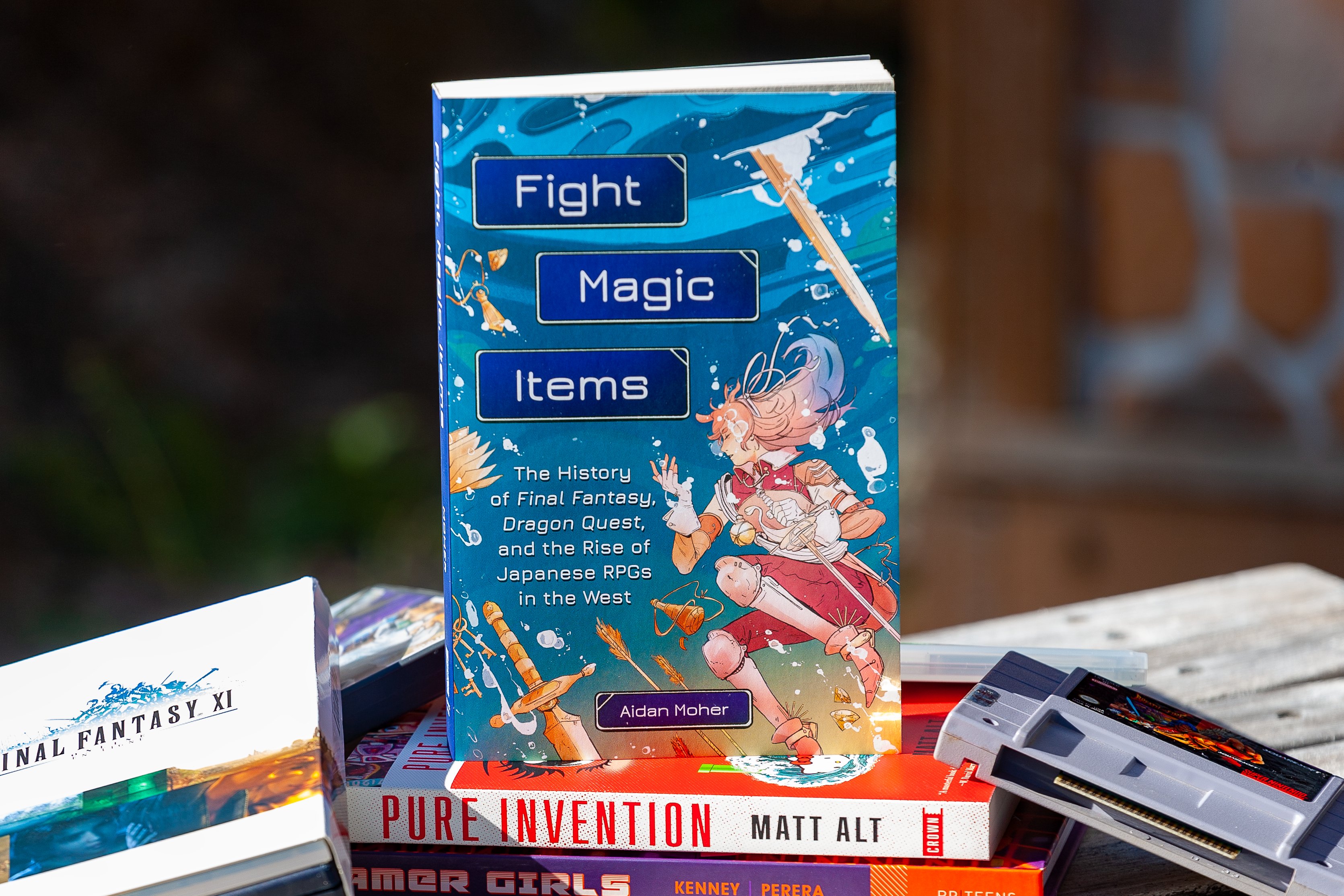It's the spring Fight, Magic, Items promo round-up!
Fight! Magic! Items!

Snowdrops are peeking through the soil, there’s a softness in the air, and my beloved Vancouver Canucks are staring down their final few weeks of hockey. Must be spring. So, here’s a round-up of recent promo and coverage of my book, Fight, Magic, Items: The History of Final Fantasy, Dragon Quest, and the Rise of Japanese RPGs in the West. I’ve got podcasts, interviews, reviews, features, and more—dig in!
If you want to know more about the book, the official Fight, Magic, Items website has everything you could possibly need!
You can also check out this thread on Twitter for a run down of ALL the Fight, Magic, Items promo since its launch in October, 2022. That’ll keep you busy with hours and hours of RPG goodness.
✨ Fight, Magic, Items is OUT NOW! ✨
— Aidan Moher (@adribbleofink) 1:28 PM ∙ Oct 4, 2022
Today's release day for my history of Final Fantasy, Dragon Quest and the rise of Japanese RPGs in the west. It's a deeply personal story about JRPGs and the people who made them.
Available everywhere.
⚔️ Get FMI: FightMagicItems.rocks
Podcasts & Interviews
Over my years, I’ve interviewed A LOT of writers, creators, and other fine folk. So, it’s always fun to have the tables turned when I get to step up as a guest on someone else’s platform. Here are a few recent interviews and guest appearances that are sure to please anyone who enjoyed Fight, Magic, Items:
Axe of the Blood God
I’ve been a HUGE fan of Axe of the Blood God since it’s creation back during the USGamer days, so it was a delight to join hosts Kat Bailey, Eric Van Allen, Nadia Oxford (who I previously podcasted with on Blood God off-shoot, Sharlayan Dropouts) and fellow guest Anthony John Agnello for an episode devoted to one of my all-time favourite games: Lunar: Silver Star Story Complete.
Axe of the Blood God is runs a series where examining classic RPGs and deciding whether they deserve a place in the “Pantheon.” If you’ve read my EGM feature “Why Lunar: Silver Star Story Complete Remains One of the Best JRPGs Ever,” you can probably guess how I voted at the end of the episode! But what about the rest of the crew? Listen and find out!
(This episode is exclusive for Axe of the Blood God patrons, but it’s absolutely worth a sub to access this episode and all the great back catalogue.)
This month's Pantheon of the Blood God is live! We're joined by @adribbleofink and @ajohnagnello to discuss whether this PlayStation, Saturn, and Mega Drive classic deserves to be in the Pantheon! Exclusive to our $10 Patrons!
— Axe of the Blood God: An RPG Podcast (@bloodgodpod) 3:04 PM ∙ Mar 1, 2023
Patreon: patreon.com/bloodgodpod
Still Loading
I had a ton of fun on the Still Loading Podcast chatting about the golden age of Japanese RPGs, my transition from book blogger to games writer, how much of modern SFF is inspired by classic Final Fantasy titles, and a bunch more.
NEW EPISODE! I'm joined by @adribbleofink to talk about his book Fight, Magic Items! We discuss how JRPG's have influenced his writing style, are we in a new golden age of JRPG's? And more!
— Still Loading Podcast (@StillLoadingPod) 12:15 AM ∙ Feb 20, 2023
#PodNation #PodernFamily stillloading.libsyn.com/still-loading-…
Retro XP
This wide-ranging two part text interview with’s covers the book’s origins, Rieko Kodama’s legendary career, Trails in the Sky, and the genre’s future.
Marc Normandin: We've seen the genre take on elements of so many others over the years, from action to MMO to deck-building to rhythm, and as you mentioned above, Japan is once again looking to the west for role-playing inspiration. What do you see as the possible next fusion that'll take off in a similarly wide fashion, rather than as a one-off?
Aidan Moher: Funny enough, I think we're actually seeing the success of western indie games like Chained Echoes and the excitement around Sea of Stars proving that Japanese RPGs don't have to be huge AAA experiences to find success. In the wake of this, as you've mentioned, we've seen companies like Square Enix experimenting with smaller scale titles (The DioField Chronicle, Triangle Strategy, Live A Live) and Konami reviving Suikoden. Since the very beginning when Hironobu Sakaguchi and Yuji Horii created the genre on NES, Japanese RPGs have thrived in environments that kept scope in check due to technical limitations, small teams, and limited budgets. I hope we see a genre that becomes more comfortable not having to be the biggest genre out there anymore.
On the wider end of the spectrum, I expect we'll continue to see major AAA releases like Final Fantasy XVI merge with the action-based gameplay and lighter RPG mechanics found in so many western franchises—Assassin's Creed, Horizon, etc. In that way, AAA blockbuster almost feels like it's becoming a genre of its own: huge world, astounding graphics, action-based combat, light roleplaying in a mostly linear story, light-to-moderate RPG character building, rinse, repeat. We're seeing this in games like Final Fantasy XVI (with Yoshi-p specifically saying they're trying to target younger fans with its action-based combat), Forspoken, etc.
So, I think the "fusion" you're talking about will be a similar pattern of big AAA action-based RPGs serving as the mainstream face of the genre, but then smaller, crowdfunded indie studios experimenting and exploring more traditional Japanese RPG structures, systems, etc. and the big studios recognizing that the success of games like Chained Echoes, or the hugely successful Eiyuden Chronicle Kickstarter, not to mention their own smaller successes, like the Live A Live remake, have proved smaller Japanese RPGs can (as they always have, going back to their proliferation on handheld consoles during the start of the HD era) exist and thrive without having to sell nine million units.
Reviews
Great reviews for Fight, Magic, Items keep rolling in from readers and critics alike! The legendary RPGFan called it “a work that will resonate with many of us who grew up with the genre and watched its rise as we ourselves grew into adulthood.”
The Geekly Grind raved, saying:
Moher’s narrative does well in sharing both his personal experiences of these momentous games, while also providing an insightful (and sometimes shocking) view of the industry as a whole. Like a proper HD remaster, Moher expertly adds color and detail to a bygone era of gaming that is growing more and more pixelated every year.
If you, like me, are endeavoring to learn more about the hobbies that you are passionate about, Fight, Magic, Items is a fantastic choice to peer into the rich history of JRPGs. Pick it up today!
Features

“How the greatest Japanese RPGs of the ‘90s came to the West” on Washington Post
Over at The Washington Post, I’ve got a deep dive feature about games localization in the late-90s, and how a small group of dedicated translators changed the way we thought about games. I speak in-depth with legendary localizers Richard Honeywood and Alexander O. Smith about their work on games like Xenogears, Vagrant Story, and Dragon Quest VIII.
Early on, Honeywood watched a dub of the game’s opening anime sequence, which had been overseen by Baskett before his departure. In it, a generational starship is attacked and destroyed by an otherworldly being, leading to the awakening of a mysterious woman on an alien planet. “Xenogears” was one of the first JRPGs to feature voice acting, so Honeywood knew it was essential to get it right for Western audiences. He noticed immediately that the voice flaps (the character’s voice acting lining up with their mouth moving) didn’t match, but, according to Honeywood, “that was the least of the problems.”
The team had a ton of questions, but “there was no real chain of command to the people who knew the answers,” he explained. And for a game as long and complex as “Xenogears,” one wrong guess could have major repercussions 50 hours of gameplay later. Under Baskett, the team figured “Xenogears” was a typical science fiction action story, Honeywood said, so their version of the anime opening called the ship’s assailants “aliens.” Honeywood saw it differently.
“That’s God attacking them, not aliens,” Honeywood told them after watching the dubbed video. “Read the script. The ship was carrying God, and now God’s attacking them. It’s very vague, but that’s what they’re hinting at in the rest of the game.”
This was a topic I touched on in Fight, Magic, Items, and I’m so pleased to be able to dig into it with the depth it deserves. If you enjoyed the book, you’re SURE to love this feature.
Read “How the greatest Japanese RPGs of the ‘90s came to the West” on Washington Post
Upcoming
In addition to all these cool jams, you’ll also be able to catch me on upcoming episodes of Every F’n FF (a book club-style podcast that covers, well, every f’n Final Fantasy game in-depth) and Retro Rockets! I’ll be sure to link them on the official Fight, Magic, Items website!
Check these out!
Already read Fight, Magic, Items? Consider leaving it a review at your favourite bookseller and Goodreads, and then check out some of these great features about Japanese RPGs:
- JRPGs is a Genre Without a Meaning (Unwinnable)
- Sorcerian, The Most Groundbreaking JRPG You've Never Played (Time Extension)
- The Elden Ring of JRPGs (Jason Schreier)
- Final Fantasy XVI has a medieval approach to diversity (The Verge)



